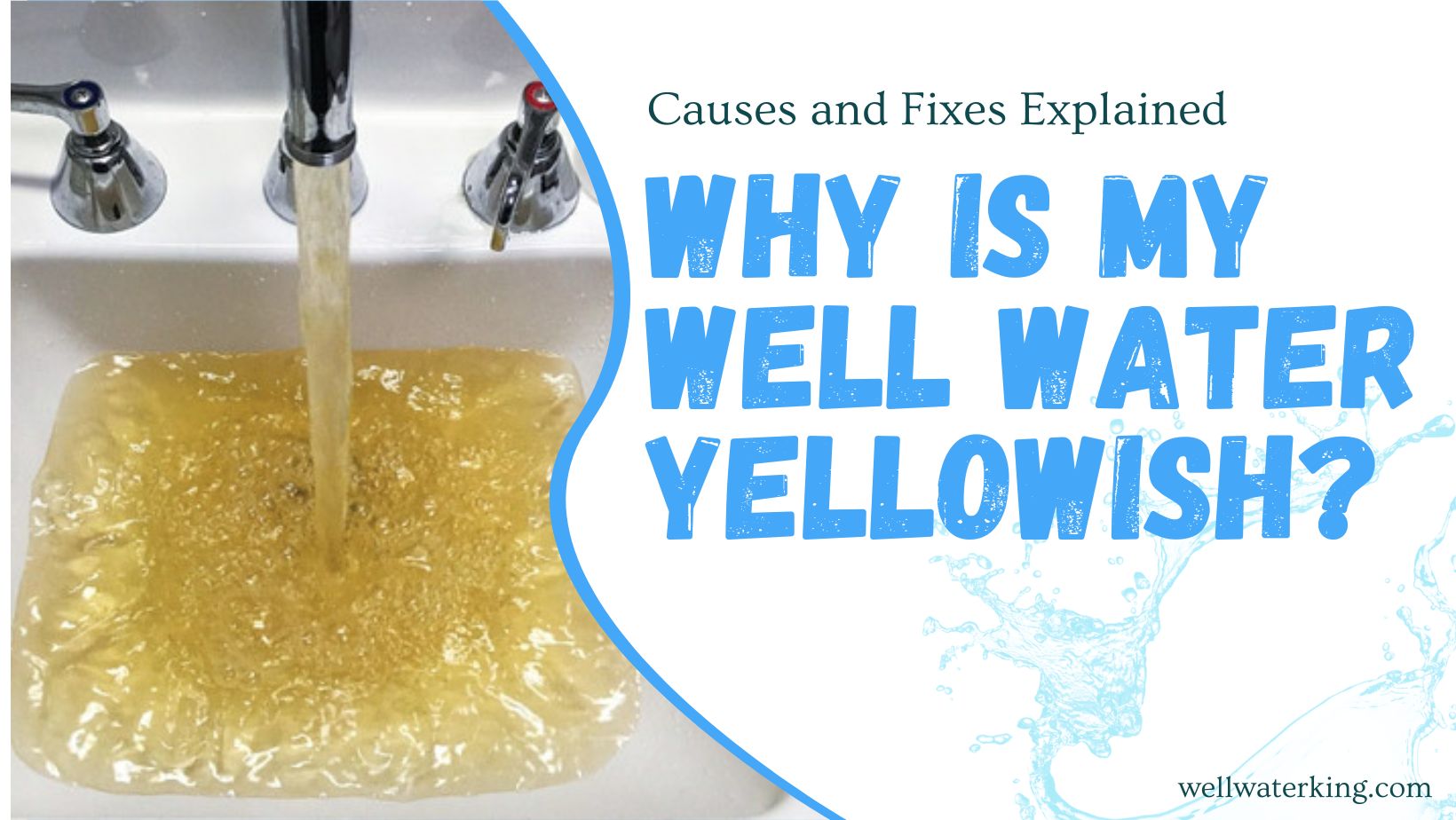You head to the faucet for a refreshing glass of water and instead find yourself staring at a yellowish, off-putting hue coming out of your tap. Your clean, safe-looking well water has suddenly taken on a suspicious shade without any explanation.
While discolored well water may seem like a cause for alarm, in most cases it is not a dire health concern. The yellowish tinge is simply an aesthetic issue stemming from high levels of naturally occurring iron, manganese, tannins, sulfur bacteria or sediment in your water source.
Still, seeing your crystal clear water turn yellowish or brownish can be jarring, and leaves you wondering – what caused this, is my water safe, and how do I fix it?
We will tackle the common culprits behind yellowish well water, look at the risks involved with drinking discolored water, provide tips on testing your well to pinpoint the cause, and review effective treatment methods to restore the clarity and purity you expect from your well.
While yellowish water may not be emergent, it often indicates developing issues like bacterial growth or corroded pipes that are best addressed sooner than later. How to decipher what is causing your water discoloration, when you should be concerned, and what can be done before the issue escalates. With some awareness and preventative care, you can keep your water flowing crisp, clear and colorful-free for years to come.
Why is my well water yellowish?
Let’s explore the top suspects behind your yellow water:
| Cause | Description |
|---|---|
| Iron build-up | Iron naturally occurs in soil and rocks. Over time it can seep into groundwater and cause a yellow to reddish-brown staining. Iron bacteria can accelerate the problem. |
| Manganese contamination | Like iron, manganese is a mineral that can be found in bedrock and soil. It can also leach into well water and create yellowish to black stains. |
| Organic materials | Decaying leaves, plants, and other organic matter can tint water yellowish. This is known as tannin contamination. |
| Rust | Corroded and rusting well casings, pipes, or pump parts can cause rusty colored water. |
| Sulfur bacteria | These bacteria thrive in wells and produce a yellowish slime and rotten egg odor. |
Is yellow well water safe to drink?
Whether yellow well water is safe to drink depends on the cause of the discoloration. Here are some key considerations on the safety of yellowish well water:
- Iron and manganese – These naturally occurring metals can dissolve into well water and cause yellowish to brown staining. While they affect taste, odor, and color, iron and manganese are not considered harmful at the levels typically found in private wells. The EPA secondary standard limits are 0.3 mg/L for iron and 0.05 mg/L for manganese.
- Tannins – Decaying vegetation and organic matter leach tannic acid into groundwater, resulting in a yellow to brown tea-like color. Tannins are not toxic themselves, but can make water unpalatable. They can also signal surface water is entering the well and carrying microbiological risks.
- Sulfur bacteria – These bacteria thrive in oxygen-deprived water and produce sulfuric acid, resulting in a yellowish color and rotten egg smell. While not directly harmful, sulfur bacteria can corrode plumbing and indicate the well is compromised. Shock chlorination is recommended to eliminate bacteria.
- Sediment – Disturbed piping or casings can allow iron sediments into water, causing yellowish red staining. While not a health hazard alone, sediment can shield microorganisms and lead to bacterial contamination. Flushing pipes and testing for coliform bacteria is advised.
The bottom line is yellowish well water is often still safe to drink, with iron, manganese and tannins being more of an aesthetic concern. However, problems like sulfur bacteria and sediment do warrant testing for other unseen contaminants. When in doubt, contact your health department or water testing professional for safety guidance.
Testing Your Well Water
To diagnose what’s causing yellowish well water, testing is needed. Here are some common tests:
- Basic water test – Checks pH, hardness, bacterial contamination, nitrates, etc.
- Iron and manganese test – Measures levels of these minerals. Over 0.3 mg/L of iron or 0.05 mg/L of manganese can cause staining.
- Tannin test – Provides tannin concentration, with over 0.1 mg/L potentially turning water yellowish.
- Bacteria test – Determines if iron, sulfur, or other bacteria are present. Special sampling bottles are used.
Home test kits or professional lab testing can check for these parameters. Testing annually or with changes in water quality is recommended.
Water Treatment Options
To remove the cause of yellowish well water, the right water treatment system is key.
- Shock chlorination – For bacterial iron and sulfur growth problems. The well is heavily chlorinated to kill bacteria.
- Iron filter – Uses filtration media to oxidize and capture dissolved iron. Periodic backwashing is required.
- Manganese greensand filter – Oxidizes and filters dissolved manganese similarly to iron filters.
- Tannin filter – Uses adsorptive media to remove tannin organic compounds through an ion exchange process.
- Distillation – Boils water and condenses the steam to remove minerals, tannins, and other contaminants.
- Reverse osmosis – Pushes water through a semipermeable membrane to filter out particles, minerals, and organics.
Some combination of filters may be needed for the best results.
Prevention Techniques for Yellow Well Water
- Maintain your well – Regularly have the well inspected and serviced to minimize corrosion and bacterial growth.
- Use a pre-filter – Install sediment pre-filters on pipes to catch iron particles and mineral buildup.
- Disinfect your system – Periodically shock chlorinate the well and pipes to control bacteria.
- Protect your wellhead – Ensure it’s sealed off from surface runoff containing organic materials and nutrients for bacteria.
- Test annually – Routine water testing lets you monitor changes and promptly address problems.
- Consider sequestration – Adding polyphosphates can keep iron and manganese dissolved and non-staining.
Addressing yellowish well water quickly preserves your plumbing, avoids unpleasant odors, and gives you peace of mind knowing your water is clean and safe.
Bottom line
Having yellowish water coming from your taps can certainly be alarming and bring up concerns. Still, noticeable discoloration or foul smells indicate it’s time to test your water. Testing helps identify the specific cause, along with any other emerging issues like coliform bacteria.
Based on test results, the proper treatment method can be implemented – whether it’s shock chlorination for bacteria, activated carbon filters for tannin removal, or a manganese green sand filter to address yellowish mineral staining.
With the right water testing and treatment protocols in place, yellowish well water can be cleared up and restored to its normal clarity. Taking a proactive approach allows you to preserve your plumbing, avoid more serious contamination risks, and have great tasting, smelling and looking water straight from your tap.



